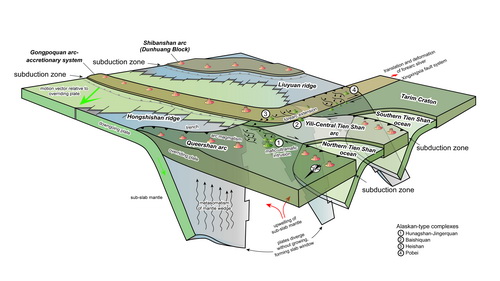Professor XIAO Wenjiao and his team describe fundamental tectonic units of the Beishan orogen and their mutual relationships, and use them to discuss the Paleozoic accretionary tectonic history and its significance for the continental growth of Central Asia.
These tectonic units were thrust imbricated and overprinted by strike-slip faulting during Permian-Triassic times, and the youngest strata involved in the deformation are Permian. Stitching plutons are Late Permian in age. Peaks of magmatic-metamorphictectonic activity, and paleomagnetic and paleogeographic data indicate that the Beishan orogenic collage evolved by development of several, Early to Mid-Paleozoic arcs in different parts of the Paleoasian Ocean. The Late Paleozoic collage is characterized by three active continental margins or island arcs that are separated by two ophiolitic melanges. The northernmost active margin is represented by the Queershan arc, which may have lasted until the Permian. The Shibanshan unit is the southernmost, subductionrelated continental arc along the northern margin of the Dunhuang block.
In the Late Carboniferous to Permian the eastern end (promontory) of the Tarim Craton probably collided with the Chinese eastern Tien Shan arc, forming a new active continental margin, which interacted with the Beishan Late Paleozoic archipelago, generating a complicated subduction-accretionary orogen; this is suggested to be one of the last phases in the development of the long-lived Altaid accretionary orogenesis.
The new model for this orogen bridges the gap between the western and eastern ends of the southern Altaids. The modern Timor-Australia collision zone with its many surrounding arcs is an appropriate analog for the Altaids in the Late Paleozoic.

Fig. 1. Speculative but viable 3D diagram illustrating the tectonic evolution of the Beishan orogenic collage from the Late Carboniferous to Early Permian.(Image by XIAO)
Xiao et al. Paleozoic multiple accretionary and collisional processes of the beishan orogenic collage. 2010, American Journal of Science, 310: 1553–1594(Download Here)